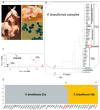Paracoccidioides brasiliensis Isolated from Nine-Banded Armadillos (Dasypus novemcinctus) Reveal Population Structure and Admixture in the Amazon Basin
- PMID: 33467393
- PMCID: PMC7829815
- DOI: 10.3390/jof7010054
Paracoccidioides brasiliensis Isolated from Nine-Banded Armadillos (Dasypus novemcinctus) Reveal Population Structure and Admixture in the Amazon Basin
Abstract
Paracoccidioidomycosis is an endemic fungal disease to Latin America caused by at least five species-level genotypes of Paracoccidioides, named P. lutzii, P. brasiliensis (S1a and S1b populations), P. americana, P. restrepiensis, and P. venezuelensis. In this manuscript, we report on Paracoccidioides sp. sampling efforts in armadillos from two different areas in Brazil. We sequenced the genomes of seven Paracoccidioides isolates and used phylogenomics and populations genetics for genotyping. We found that P. brasiliensis and P. lutzii are both present in the Amazon region. Additionally, we identified two Paracoccidioides isolates that seem to be the result of admixture between divergent populations within P. brasiliensis sensu stricto. Both of these isolates were recovered from armadillos in a P. lutzii endemic area in Midwestern Brazil. Additionally, two isolates from human patients also show evidence of resulting from admixture. Our results suggest that the populations of P. brasiliensis sensu stricto exchange genes in nature. More generally, they suggest that population structure and admixture within species is an important source of variation for pathogenic fungi.
Keywords: Amazon; Paracoccidioides; admixture; armadillos; paracoccidioidomycosis.
Conflict of interest statement
The authors declare no conflict of interest.
Figures


Similar articles
-
Phylogenetic Species of Paracoccidioides spp. Isolated from Clinical and Environmental Samples in a Hyperendemic Area of Paracoccidioidomycosis in Southeastern Brazil.J Fungi (Basel). 2020 Aug 11;6(3):132. doi: 10.3390/jof6030132. J Fungi (Basel). 2020. PMID: 32796579 Free PMC article.
-
Ecology of Paracoccidioides brasiliensis, P. lutzii and related species: infection in armadillos, soil occurrence and mycological aspects.Med Mycol. 2018 Nov 1;56(8):950-962. doi: 10.1093/mmy/myx142. Med Mycol. 2018. PMID: 29325170
-
Characterization of a Paracoccidioides spp. strain from southeastern Brazil genotyped as Paracoccidioides restrepiensis (PS3) and review of this phylogenetic species.Genet Mol Biol. 2020 May 29;43(2):e20190201. doi: 10.1590/1678-4685-GMB-2019-0201. eCollection 2020. Genet Mol Biol. 2020. PMID: 32502230 Free PMC article.
-
Paracoccidioides and Paracoccidioidomycosis in the 21st Century.Mycopathologia. 2023 Apr;188(1-2):129-133. doi: 10.1007/s11046-022-00704-y. Epub 2023 Jan 12. Mycopathologia. 2023. PMID: 36633737 Review.
-
Paracoccidioidomycosis: Current Status and Future Trends.Clin Microbiol Rev. 2022 Dec 21;35(4):e0023321. doi: 10.1128/cmr.00233-21. Epub 2022 Sep 8. Clin Microbiol Rev. 2022. PMID: 36074014 Free PMC article. Review.
Cited by
-
Molecular epidemiology of Paracoccidiodes spp. recovered from patients with paracoccidioidomycosis in a teaching hospital from Minas Gerais State of Brazil.PLoS Negl Trop Dis. 2021 Nov 29;15(11):e0009956. doi: 10.1371/journal.pntd.0009956. eCollection 2021 Nov. PLoS Negl Trop Dis. 2021. PMID: 34843484 Free PMC article.
-
Molecular eco-epidemiology of Paracoccidioides brasiliensis in road-killed mammals reveals Cerdocyon thous and Cuniculus paca as new hosts harboring this fungal pathogen.PLoS One. 2021 Aug 24;16(8):e0256668. doi: 10.1371/journal.pone.0256668. eCollection 2021. PLoS One. 2021. PMID: 34428263 Free PMC article.
References
Grants and funding
LinkOut - more resources
Full Text Sources
Other Literature Sources

